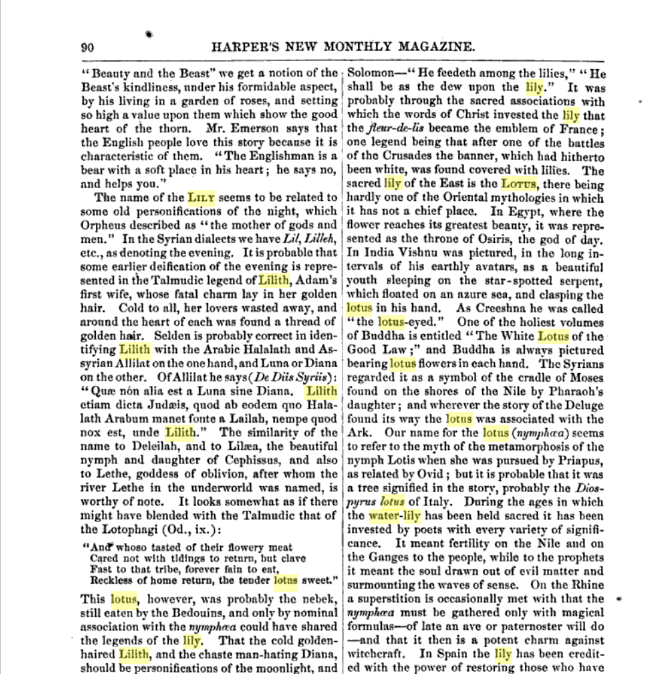The blue water lily, also known as the blue lotus or sacred blue lily, is prominently featured on the pillars, stone alters and other parts of ancient Egyptian temples. It holds a significant place in Egyptian mythology and is regarded as a symbol of the sun and a sign of rebirth.
Legend has it that there was an island inhabited by people who spent their days eating lotus flowers. Throughout history, many have speculated where the island is located. Polybius wrote that the island was callled Djerba, and was located off of the coast of Tunisia. Strabo concurred with this location in his writing, while Pseudo-Scylax noted lotus-eaters in northern and central Dalmatia.
The plant acted as a narcotic and affected people much like people found in opium dens of the past; forgetting everything about their lives and desiring only to be with other lotus-eaters. While it is not written, I wonder if the antidote was the Forget-Me-Not? I could imagine a wise witch wife giving it to her husband as he is about to be dispatched to the island.
What is not known, however, is which plant the Greek word lotos is referring to. The ancient Greeks used the word to identify several different flowers. My first guesses would have been the fruit (persimmon) of the date-plum or even the poppy. That was until I saw the name of a possible candidate–Ziziphus lotus. Today Ziziphus spinosa is used as a sedative and hypnotic. Several other species of Ziziphus are also seen as curative. However, what was most interesting to me was the possible connection to the thorns said to have been woven into a crown for the man known as Jesus to wear at his Crucifixion.
If one looks at the English word for Crucifixion, it is not terribly phonetically far from the English word for Coronation.
The jujube is of the botanical order of Rosales and clade Angiosperms. The term Angiosperms comes from the Greek word angeion (meaning “container” or “vessel”) and sperma (meaning “seed”). One could speculate on this in the context of the Holy Grail, but also worth considering is that it was actually those acting in concert against the woman known as Mary or even God who were the perpetrators of the death of the man known as Jesus. Strangely, there is no mention of his step-father, Joseph, after the 12th birthday of the man known as Jesus. This is the age when Merovingian royals were regarded as kings. Could the reference to him being king not be of the Jews but, in actuality, be of the Merovingians? And did Joseph voluntarily leave the family or was he killed? Was the family targets in some way? Perhaps he had to leave in order to curb aggression toward Jesus–much like a werewolf would.
Also strange is the current regard for the Jujube tree. Of all the trees in the Middle East, the Ziziphus spina-christi is the only one considered holy by Muslims. It is also considered a sacred tree within the whole of the Middle East. Of note, though, is its status as “blessed” among the Druze–known as the “Freemasons of the East.”
What is not known is whether this tree is venerated pre- or post-Christ or if there is mythology relating to the tree pre-Christianity. And are they honoring the tree because they respected the man known as Jesus, hated the man known as Jesus or the meaning of the tree surpasses the man known as Jesus. Meaning, was Jesus honored, punished and hated or possibly ritually sacrificed?
https://ethnobiomed.biomedcentral.com/articles/10.1186/1746-4269-1-8
https://www.pbs.org/wnet/wideangle/interactives-extras/photo-galleries/contestant-no-2-slideshow-who-are-the-druze/5255/
If the mysterious lotus eaters were not partaking of the jujube fruit, then the next candidate would be the Lily of the Nile. The jujube fruit is known as the red or Chinese date. The lotus was known to have been used widely in the medicine of China and India. Could this point to the Jesus/Buddha mono-myth or, more importantly, to either the origin or enemies of the holy bloodline?
https://www.jstor.org/stable/4253981
http://www.diva-portal.org/smash/get/diva2:1560422/FULLTEXT01.pdf
Four things are to be remembered relative to this thought. First, we do not speak the ancient languages and so our understanding of them or their relation to each other is an educated guess. Second, the situations that have remained mysteries are likely that way for a reason. Whether dealing with myth, unscrupulous individuals or mystery schools, the symbolism recorded in certain events may be lost on us. Third, readers must pay attention to the etymology of words and how they correspond to those in other languages or tie to various tribes around the world and their places. Finally, we are dealing with ancient oral traditions. Further, in looking to the past, we are often finding changed, forged and fabricated histories.
Try to think of this process as bits of a map and not as puzzle pieces. Are you trying to arrive at a destination and enjoy the journey or are you looking for the self-satisfaction of solving a puzzle for which there is no box image to guide you or confirm that you are correct? For the kindred, maybe it is more a matter of understanding the interrelated past in order to move beyond division of our kinds and forge the future truly meant for us.


